It’s not uncommon for revenue to slide. It happens to all sales organizations at one time or another. Revenue being down isn’t the most difficult problem. Knowing why revenue is down and where to look is the biggest challenge. This post is gonna lay the four areas CSO’s/Heads of Sales should be looking if their revenue is on the slide.
When sales are down there are only 4 levers leadership can pull to improve sales. That’s it. Knowing what these levers are and how the organization is faring in each of them can be the difference between further decline or growth.
When sales are down, organizations have a tendency to run around throwing shit against the wall hoping something sticks. The pressure to perform in sales is huge and when performance is down the pressure is ratcheted up. Too often, reactive, misaligned, and ineffective initiatives are put in place, rarely yielding the desired effects.
The best thing to do to keep this from happening is to break your sales team into manageable sections: strategy, structure, people, process.
Each of these pillars represents the critical parts of sales and are the only areas leadership can control to move the number.
Strategy:
What’s the go to market strategy? What strategy/strategies are you executing to? Do the strategies map to the stated goals. Are they creative and provide a competitive advantage? Has the strategy taken into consideration the market opportunities and competitive challenges? Does it clearly lay out the direction or the current state/future state?
Take a look at your strategy. Is it still relevant? Are you executing to it well? Do you have one at all? Is it working? Does it need to be adjusted? Is it still aligned with the market trends and opportunities? Is it big enough? Ask yourself, do you have the right strategy in place to be successful.
If the strategy is wrong, if the strategy is not aligned with the market, if you don’t have a strategy or you are executing it poorly, your probability for success is very low. The strategy is how you are leveraging your resources, your people, the processes, capital and more. When sales are falling, take a look at your sales strategy. Put it through the ringer and make sure it’s the right one. (You can get a killer strategy development template here)
Structure:
Structure follows strategy. The structure is the frame for strategy; it’s what gives it strength. If the structure doesn’t support the strategy, everything comes tumbling down. Structure is how the organization is set up, it’s services, inside sales, outside sales, sales engineers, sales operations, sales enablement, etc. Structure comprises of the components that drive the sales strategy and allows for execution.
If the structure isn’t aligned with the strategy or is poorly constructed, AKA, needing inside sales and only having outside, requiring hunting teams, but building farming teams, you are in trouble. Step back and look at your current structure. Does it map to the strategy? It is optimal for creating the results you are looking for? Is there anything missing? Comp plans are also part of structure. Do your comp plans support your strategy? How well does your structure support the strategy?
Take the time to evaluate your organization’s structure. Map it to the needs of the strategy. Make sure it’s developed in a way that drives the strategy and not inhibit it. Structure is too often missed, but very important.
People:
This is the biggest problem with sales organizations period. Having the right people in the right roles is without a doubt the greatest challenge to sales organizations. It’s people who have to execute and if they don’t, nothing happens. Therefore, if the people part isn’t correct, nothing else matters.
The key here is to make sure you have the right people. Do you have the right skill sets performing the right roles? Do you have the right cultural fit? Do you have the people you need to execute the strategy? Knowing this with confidence is critical.
Taking the time to evaluate the team and whether or not you have the right people in the right roles could be the single most effective thing you can do for success. Build a tool that allows you to measure the team in relation to the goals and strategy. Take an inventory of the type of skills required to execute, then rate the entire team across those skills. Know how well positioned your people are for success and know what skills areas you are deficient. This knowledge will provide you with a roadmap on what needs to be addressed and where you are strong. It will keep you from developing a people or talent gap. (You can get a great sales team assessment template here)
Process:
To keep everything running smoothly, to maintain velocity and efficiency and to ensure the team is operating effectively, processes have to be nailed. Lack of process is like throwing a monkey wrench into the gears. Bad processes can impede time to market, undermine execution, increase costs, upset customers, effect time to deliver, etc. No matter how good the strategy is, how sound the structure and how talented the people, if the processes aren’t crushing it, you’re leaving money on the table.
Stop and take a good hard look at your processes. What does your sales process look like? Does it align with your buyers’ buying proces? How solid is your pipeline meeting process? Do you have a coaching process or cadence? Is it working? What does your people development process look like? What about your lead management process, lead follow up, or lost deal process? Are you getting the most our of your strategy, structure and people with killer, effective, efficient processes?
Implementing light, functional, and effective processes is like putting nitrous in your car — boom! Take the time to evaluate your current processes and ensure they too align with your strategy. Make sure they support the structure and ensure they empower the people.
When sales numbers are down or you want to get more revenue, there are only four areas leadership can tinker with — that’s it!
They can address the strategy. They can redo the structure. They can hire, fire, or fix the people. They can implement new processes or get rid of the old bad ones. That’s it folks. The best way to manage a sales organization is to manage it across these four categories. It’s to keep a score card on each of the pillars and continually measure them.
Step back and look at your sales organization. What is your strategy? Now, grade it. Does your structure support the strategy? Now, grade it. Look at your people, are they the right team? Are the right people in the right roles? Grade them. How effective are your processes? Do they enable growth? Do they empower and accelerate? Grade them.
Start running your business along these 4 sections. They are the only levers you can pull to make your number, so you’re better off knowing where you stand ahead of time. Because, if things go bad, that’s where you’ll go to fix em.

